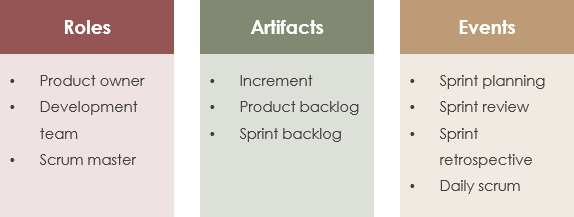The 4 Amazing Scrum Events
- Sprint Planning
- Daily Scrum
- Sprint Review
- Sprint Retrospective

Table of Contents
The Scrum Events
Per Scrum Guide, prescribed events are used to create regularity and to minimize the need for meetings not defined in Scrum. All events are time-boxed events, such that every event has a maximum duration. Once a Sprint begins, its duration is fixed and cannot be shortened or lengthened. The remaining events may end whenever the purpose of the event is achieved, ensuring an appropriate amount of time is spent without allowing waste in the process.

Sprint Planning
Sprint Planning is one of the Scrum events where the work to be performed in the Sprint is planned at the Sprint Planning. This plan is created by the collaborative work of the entire Scrum Team.
Sprint Planning answers the following:
- What can be delivered in the Increment resulting from the upcoming Sprint?
- How will the work needed to deliver the Increment be achieved?
Daily Scrum
The Daily Scrum/Standup is a 15-minute time-boxed event for the Development Team. The Daily Standup is held every day of the Sprint. At it, the Development Team plans work for the next 24 hours. This optimizes team collaboration and performance by inspecting the work since the last Daily Scrum and forecasting upcoming Sprint work. The Daily Standup is held at the same time and place each day to reduce complexity for the team to answer the following questions:
- What did I do yesterday that helped the Development Team meet the Sprint Goal?
- What will I do today to help the Development Team meet the Sprint Goal?
- Do I see any impediment that prevents me or the Development Team from meeting the Sprint Goal?
Sprint Review
A Sprint Review is one of the Scrum events that is held at the end of the Sprint to inspect the Increment and adapt the Product Backlog if needed. During the Sprint Review, the Scrum Team and stakeholders collaborate about what was done in the Sprint. Based on that and any changes to the Product Backlog during the Sprint, attendees collaborate on the next things that could be done to optimize value. This is an informal meeting, not a status meeting, and the presentation of the Increment is intended to elicit feedback and foster collaboration.
The Sprint Review includes the following elements:
- Attendees include the Team and key stakeholders invited by the Product Owner;
- The Product Owner explains what Product Backlog items have been “Done” and what has not been “Done”;
- The Development Team discusses what went well during the Sprint, what problems it ran into, and how those problems were solved;
- The Development Team demonstrates the work that it has “Done” and answers questions about the Increment;
- The entire group collaborates on what to do next, so that the Sprint Review provides valuable input to subsequent Sprint Planning;
Sprint Retrospective
The Sprint Retrospective is one of the Scrum events and it is an opportunity for the Scrum Team to inspect itself and create a plan for improvements to be enacted during the next Sprint.
The Sprint Retrospective occurs after the Sprint Review and prior to the next Sprint Planning. This is at most a three-hour meeting for one-month Sprints. For shorter Sprints, the event is usually shorter. The Scrum Master ensures that the event takes place and that attendants understand its purpose.
The purpose of the Sprint Retrospective is to:
- Inspect how the last Sprint went with regards to people, relationships, process, and tools;
- Identify and order the major items that went well and potential improvements; and,
- Create a plan for implementing improvements to the way the Scrum Team does its work

